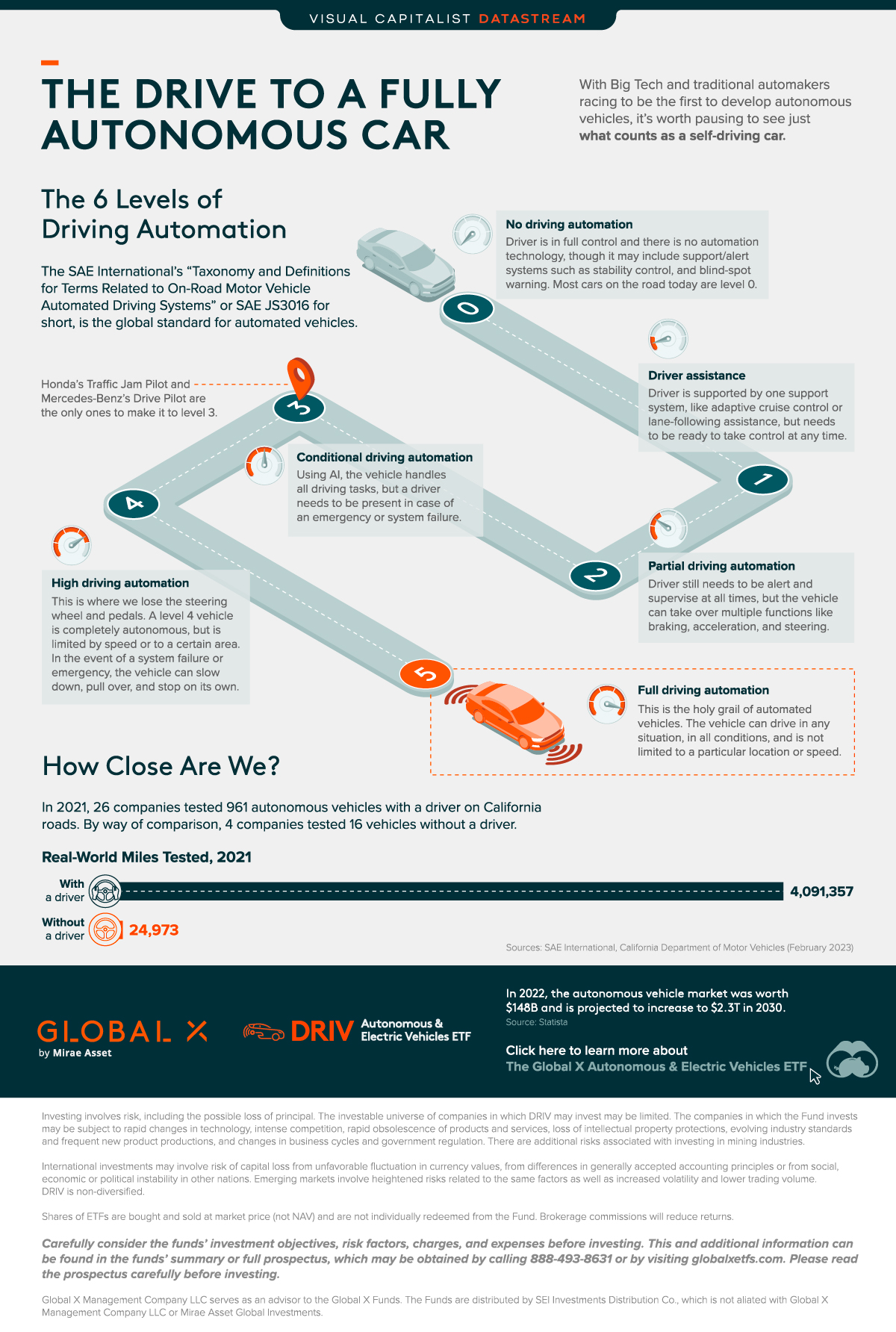
Written By Chris Dickert
Graphics & Design
- Miranda Smith
Published March 8, 2023
•
Updated March 8, 2023
•
The following content is sponsored by Global X ETFs
The Briefing
- SAE International, the global standards and engineering association, has come up with a six level taxonomy for automated cars.
- In 2021, 26 companies testing 1,174 autonomous vehicles (with a driver) logged over 4 million miles on California roads. Four companies logged only 25,000 miles using driverless vehicles.
The Drive for a Fully Autonomous Car
Until quite recently, the autonomous car was the stuff of science fiction. More hype than happening some time soon.
But with automakers spending billions to develop the technology—$75 billion by one count—the race is on to be the first to launch a fully self-driving vehicle.
This visualization from our sponsor Global X ETFs, takes a look at the drive for a fully autonomous car.
From the Flintstones to the Jetsons
What does it mean to say that a car is autonomous? Does a human driver need to be ready to take over? Can it drive on its own all or just some of the time? And do driving conditions need to be ideal or can it handle the odd thunderstorm?
Fortunately, SAE International, the global standards and engineering association, has come up with the creatively-named “Taxonomy and Definitions for Terms Related to On-Road Motor Vehicle Automated Driving Systems,” or SAE JS3016 for short.
The Six Levels of Driving Automation
The system has six levels of automation and spans a yawning gulf of features. Level zero is analogous to Fred Flintstone’s foot-powered, stone age car, while level five is something like George Jetson’s futuristic, bubble-blowing flying saucer.
Level 0: No Driving Automation
The driver is in full control and there is no automation technology. It may include support or alert systems such as stability control and blind-spot warning. Most cars on the road today are level zero.
Level 1: Driver Assistance
The driver is supported by one support system, like adaptive cruise control or lane-following assistance, but needs to be ready to take control at any time.
Level 2: Partial Driving Automation
The driver still needs to be alert and supervise at all times, but the vehicle can take over multiple functions like braking, acceleration, and steering, using Advanced Driving Assistance Systems (ADAS). The Tesla Autopilot feature is generally understood to fall under level two.
Level 3: Conditional Driving Automation
After this point you are not considered to be driving, even if you’re seated in the driver’s seat. Using artificial intelligence (AI), the vehicle handles all driving tasks. A driver still needs to be present in case of an emergency or system failure. Honda’s Traffic Jam Pilot and Mercedes-Benz’s Drive Pilot are the only ones to hit this milestone.
Level 4: High Driving Automation
This is where you lose the steering wheel and pedals. A level four vehicle is completely autonomous, but is limited by speed or to a certain geographic area. In the event of a system failure or emergency, the vehicle can slow down, pull over, and stop on its own. A driverless taxi or public transport would be a likely application at this level.
Level 5: Full Driving Automation
This is the Holy Grail of automated vehicles. At this level, humans are completely superfluous and need only set the destination and sit back and enjoy the ride. The vehicle can drive in any situation, in all conditions, and is not limited to a particular location or speed.
So When Can I Watch Netflix While Driving?
Probably not anytime soon, if figures from California’s Department of Motor Vehicles are any indication.
The Pacific state is home to a host of autonomous vehicle manufacturers, many based in Silicon Valley, all eager to test their technology on public roadways. As a result, the DMV has developed regulations for testing self-driving cars, both with and without a driver.
Part of the rules require that manufacturers file annual reports about their activities. According to these, at the end of 2021, 26 companies testing 1,174 autonomous vehicles (with a driver) logged over 4 million miles on California roads. By way of comparison, four companies logged only 25,000 miles using driverless vehicles.
If you take the miles covered as a proxy for how far the technology has progressed, testing on systems that still require a driver—so level 3 at best—is miles ahead of driverless systems, or level 4 and up.
Hey Siri, Which Way Next?
In addition to being a really tough engineering problem, autonomous cars also raise tricky ethical questions.
Part of the difficulty has been trying to get a machine to make the same choices as human drivers would. What if the brakes fail and the AI has to make a split-second decision? Does it swerve to avoid a pedestrian and into a telephone pole, maybe killing the passenger, or keep driving?
Problems such as these are often covered in philosophy under the Trolley Problem, which features a runaway trolley and a switch. Throw the switch and save a life, but maybe take another?
Tackling this problem, which can get a bit absurd at times, is a good way to discover the “right” answer to ethical questions. Autonomous car manufacturers are going to have to have an answer in any autonomous future.
Invest in the Future of Road Transport
With autonomous car technology advancing at leaps and bounds, there are plenty of opportunities to invest in the companies working to make it a reality.
Learn more about the Global X Autonomous & Electric Vehicles ETF (DRIV), which provides exposure to companies involved in the development of autonomous vehicles, EVs, and EV components and materials.
You can also learn how experiential technologies like AI are driving change in road transport in Charting Disruption, a joint report by Global X ETFs and the Wall Street Journal (also available as a downloadable PDF).

Please enable JavaScript in your browser to complete this form.Subscribe to our free newsletter and get your mind blown on a daily basis: *Sign up
Related Topics: #Cars #technology #autonomous cars #artificial intelligence #electric cars #Global X #Global X ETFs
Click for Comments
var disqus_shortname = "visualcapitalist.disqus.com";
var disqus_title = "The Drive for a Fully Autonomous Car";
var disqus_url = "https://www.visualcapitalist.com/sp/the-drive-for-a-fully-autonomous-car/";
var disqus_identifier = "visualcapitalist.disqus.com-155761";
You may also like
-

VC+7 mins ago
NEW FEATURE: Unlock the VC+ Archive in March
This month sees the launch of the VC+ archive, giving easy access to all past content we’ve sent out alongside March’s special features.
-

Markets1 day ago
Ranked: The World’s Most Valuable Bank Brands (2019-2023)
This infographic ranks the 10 most valuable bank brands over the past five years (Spoiler: U.S. banks aren’t in the top four)
-

Energy2 days ago
Mapped: Asia’s Biggest Sources of Electricity by Country
Asia is on its way to account for half of the world’s electricity generation by 2025. How is this growing demand currently being met?
-

Money2 days ago
Ranked: Who Are the Richest People in Africa?
This infographic ranks the wealthiest 15 billionaires on the African continent.
-

Markets2 days ago
Visualized: The State of the U.S. Labor Market
The U.S. labor market is remarkably strong, with a 3.4% unemployment rate. Which sectors are seeing the highest job gains in 2023?
-

Energy6 days ago
Which Countries are Buying Russian Fossil Fuels?
While Russia still makes billions from fossil fuel exports, revenues are declining. Here are the largest importers since the start of the invasion.
Subscribe
Please enable JavaScript in your browser to complete this form.Join the 380,000+ subscribers who receive our daily email *Sign Up
The post The Drive for a Fully Autonomous Car appeared first on Visual Capitalist.